Snowberry and its cultivation
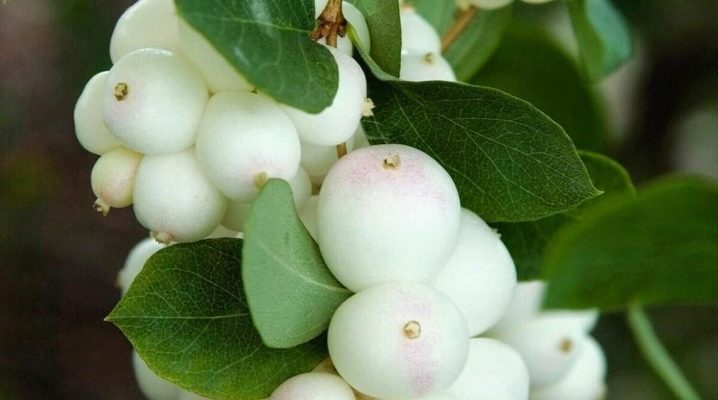
The deciduous shrub, known as "snowberry" or "wolfberry", has been planted for landscaping parks and squares for about 200 years. One of the most common ornamental plants tolerates gas pollution in modern cities, so it can often be seen in green areas of multi-storey buildings. The attractiveness of the plant is given by large leaves and clusters of pinkish fragrant inflorescences.
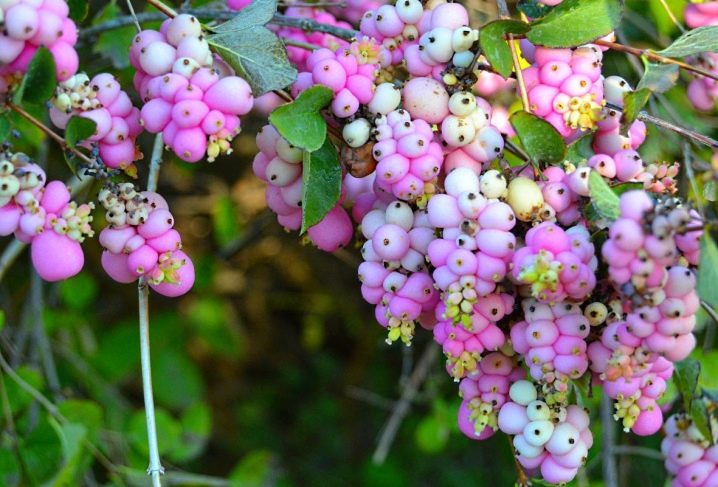
general description
The ornamental snowberry belongs to the large family of honeysuckle shrubs. On the territory of both American continents, approximately 15 different species belonging to this genus are found in the wild. Only one type of snow berry is found in China, and the name of the plant is translated from Greek as "gathered together." It has to do with the peculiarity of the fruits of the plant, always closely pressed against each other.
The berries are famous not only for their density on the brushes, but also for the length of time they stay on the branches, despite frost and other atmospheric phenomena. For humans, they are not of food interest, since they contain toxic substances. However, they are not dangerous for birds and during the snowy winter they are a good help for survival.
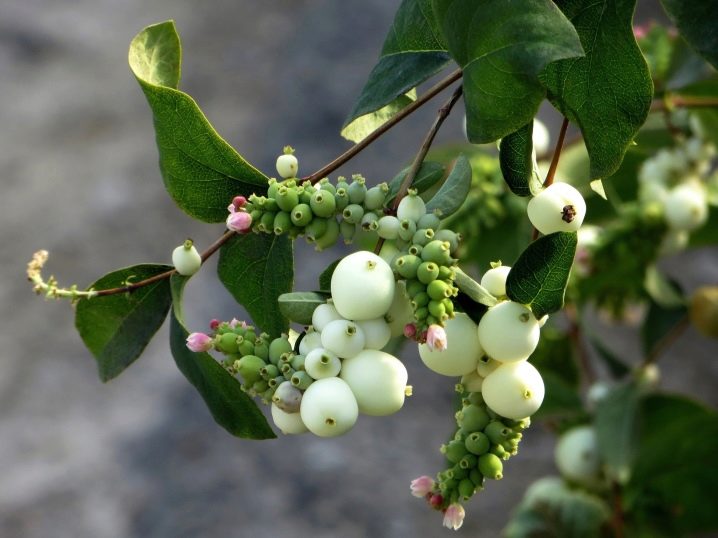
Wild quails, hazel grouses, sparrows and waxwings happily feed on brightly colored berries hanging attractively from bare branches.
The height of the shrub is from 0.2 to 3 meters, depending on the variety. The leaves are rounded and are attached to the branches with a strong short petiole. The leaflets reach 15 cm in length; at the very base, they can have 1-2 lobes. The branches of the snowfield are very flexible, so they are able to withstand heavy loads in winter and not break under the weight of precipitation and icing.
The clusters of inflorescences are located either in the axils of the leaves or at the ends of the branches. Each inflorescence can consist of 5-15 buds. Flowers of a pinkish or yellow-green hue bloom from July to August, spreading a pleasant aroma with honey notes around the plant. The shrub attracts many insects, including being a good honey plant.
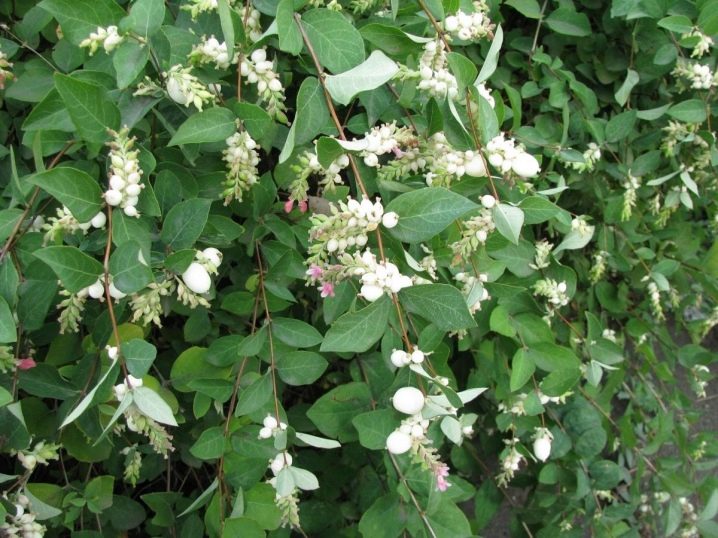
In autumn, berry seed fruits appear on the bushes, painted in white, red and black-purple colors.
Snowberry fruits look like small balls of regular shape, but there are also some elongated ones. Inside the berry there is one oval-shaped bone, somewhat flattened from the sides. The pulp of the berries looks like fine dry snow. The most hardy and suitable for growing in unfavorable environmental conditions is the variety of shrubs with white berries, while the red and black wolfberry can be more often seen in forest plantations or in vast park areas.
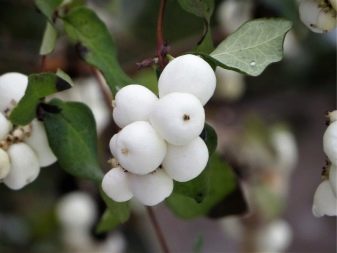
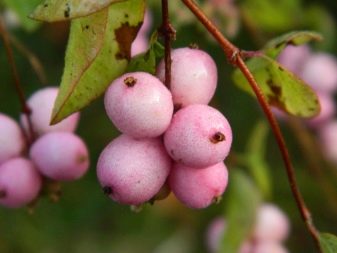
Views
There are more than 15 different species in the genus of the snowberry, but only a small number of them are cultivated. One of the first varieties of the plant, which was described by botanists, is a white ordinary (snow) bush that grows in riverside areas, along the banks and slopes of reservoirs. The wild-growing shrub forms a beautiful round-shaped crown, consisting of arched thin branches and oval leaves painted in gray-green, malachite colors. Due to its resistance to severe frosts, this species has been used for more than 100 years for the design of parks and squares in the northern regions. As already noted, the fruits of the bush cannot be eaten, since they are poisonous.
An interesting ornamental variety of shrubs called "Magic Berry", which has a small size, growing up to 100 cm in height and 120 cm in width.
It stands for a long time in the cold season with clusters of purple-pink fruits that look like flowers against the background of snow. The hybrid is able to survive in frosts down to -35 degrees.

Shrub saplings "Maser of Pearl" can be purchased at many ornamental nurseries. Among the same series of hybrids bred in the Netherlands, there is another variety - "Amethyst". They are characterized by a tendency to form a crown in a horizontal plane and bloom with beautiful white-purple buds. They are resistant to frost, but they do not tolerate snowless winters well, so young plants must be covered.
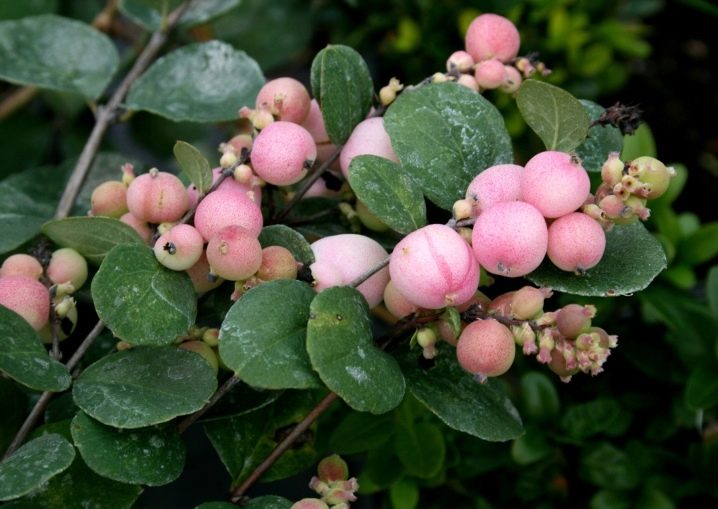
A fast growing ornamental round-leaved shrub of the "Hancock" variety is a graceful plant about 1 meter in height. It looks good in compositions with coniferous and deciduous trees. The fruits of the hybrid look like small pink balls, collected in small clusters, but the beautiful berries are not edible.
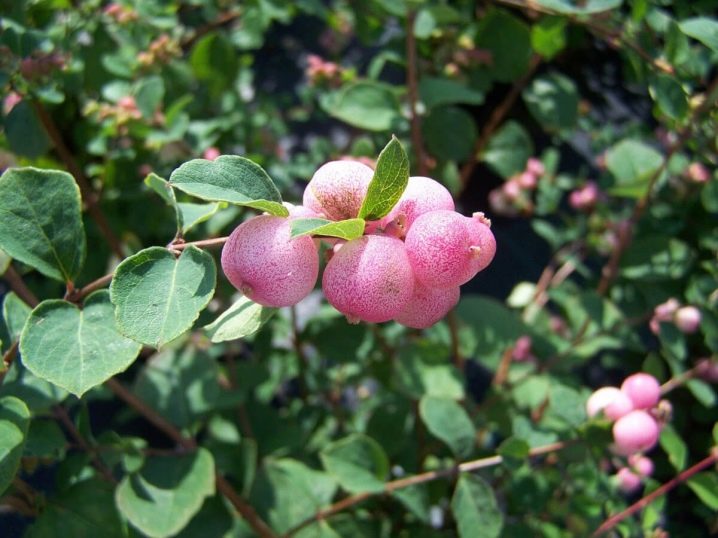
An adult plant of the "Henault" variety grows up to 1.5 m in height, it has the same size in width. The dark green leaves on the underside have a purple tint, which in autumn becomes the main one for the entire crown. Beautiful lilac fruits hang on the branches for a long time, prompting many children to ask adults if they can be eaten.
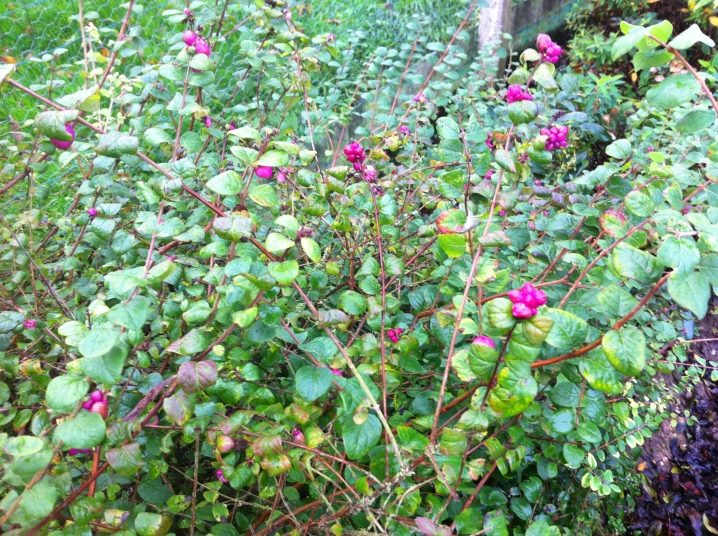
One of the most beautiful ornamental shrubs in landscape compositions are tall, up to 1.8 meters, snowberry bushes of the Folis Variegatus variety. During flowering, it is not so noticeable with its small greenish buds, as during the ripening period of berries, which stand out brightly against the background of the leaves with purple-red spots. They often hang on branches until spring, remaining even during a snowy winter as a decoration for garden or park plantings.

Landing
Snowberry seedlings can be planted outdoors in autumn or spring. An unpretentious shrub grows well in illuminated places with both wet and dry soil. The plant has a well-branched root system, so it can be planted on slopes with mobile soil to strengthen the subgrade against further slippage.
Before planting the bushes, you should prepare the site in advance by digging and clearing it of weeds. And also you need to add rotted manure as fertilizer. Preparatory activities are carried out 3-4 weeks before planting. When creating a single or group landscape composition, holes are prepared with dimensions of 0.65x0.65 m. Between individual seedlings, you need to adhere to a distance of 1.2-1.5 meters. In cases where the ornamental shrub is planted in one line, then a trench of the required length is dug, the width of which is 0.4 meters and the depth is 0.6 meters.

Within 1 meter of the trench, you can plant 4-5 seedlings to get a dense green fence.
In heavy clay soils, it is necessary to arrange at the bottom of the planting pits or trenches drainage from sand and gravel, which are stacked on top of each other in layers of 10 cm each. On top of the drainage, it is necessary to lay a nutritious soil consisting of peat, compost and river sand. 0.6 kg of ordinary wood ash is added to the backfill for 1 bush, as well as 0.2 kg of superphosphate and dolomite flour each. Before planting, it is useful to hold the roots of seedlings in a clay mash for 30-40 minutes. When backfilling the root system with soil, it is important to ensure that the root collar remains above its surface. In the first 4-6 days after planting, the young plant must be watered daily so that it is constantly in the moist soil.

Care
Ornamental snowberry bushes survive in the most difficult conditions of open ground, they have earned the characteristic of very unpretentious plants. But any attention of the gardener in the form of watering or feeding will affect the external qualities and the healthy state of the shrub. After planting seedlings, their near-stem zone can be sprinkled with peat or other type of mulch... Just like with other cultivated plants, it is necessary to periodically clean the soil around the shoots from weeds in the snowberry, loosen it and water it. The plant should be watered only during dry periods, doing it in the evening, in the amount of 15-20 liters per 1 bush. During the rainy season, additional watering should be stopped, and after the end of wet weather, shallowly weed the root soil.
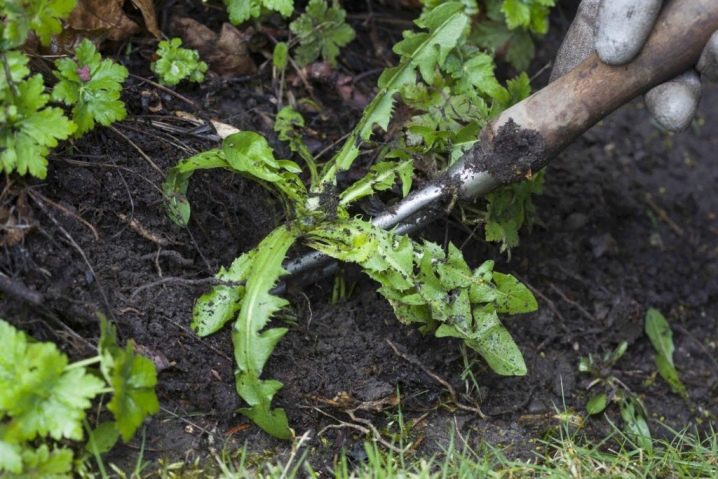
Top dressing
During the autumn digging of land in the garden, it is useful to add rotted plant compost to the ground. In spring, before the leaves begin to bloom, organic fertilizers must be applied under the shrub in the form of rotted manure mixed with humus, superphosphate and potassium salt in an amount of 0.1 kg.
When growing ornamental plants in conditions of too poor and stony soil, you can arrange a second top dressing in the summer, closer to the middle.
To do this, take 50 grams of Agricola and stir them in 1 bucket of warm and clean water.

Pruning
An ornamental plant needs sanitary and rejuvenating pruning, which is carried out at the end of winter or early spring, without waiting for the start of sap flow. During this period, dry, damaged and diseased shoots are removed. In areas that are too thick, several branches can be removed. At the same time, the height of the plant is also adjusted, which is necessary for solving the aesthetic problems of landscape design.
Old shoots can be shortened. This will not affect the flowering of the bushes, since flower-bearing clusters appear on young branches of the current year.
After shearing, the snowberry very quickly goes through the recovery period and starts active growth. Too thick branches after pruning must be treated with garden pitch so that they do not cause infectious diseases for the entire bush. After 8 years of cultivation, many types of snowberries need rejuvenating pruning in order to restore the large sizes of flowers and fruits, and make shoots that are too elongated in length shorter and more luxuriant.
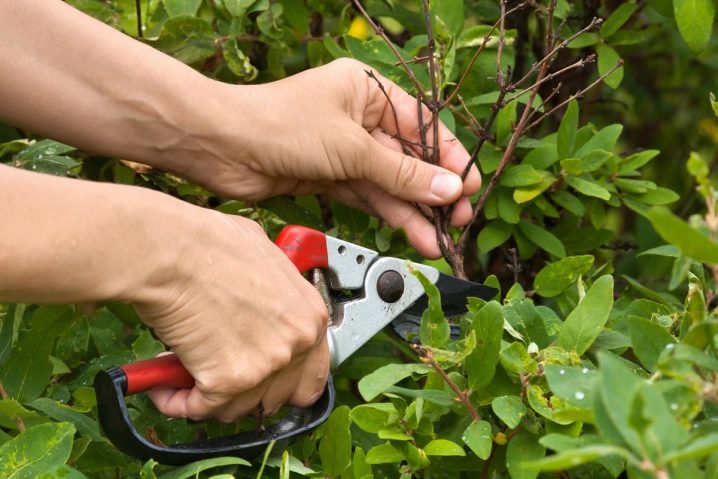
Transfer
Snowberry bushes quickly form a branched root system, so they should be transplanted as early as possible. The unpretentiousness of the shrub is also expressed in its quick adaptation to a new permanent place of life. The transplant should be carried out in the same way as planting, in the autumn or spring. The preparation of the planting holes is also done in advance, with a drainage layer and the preparation of nutrient soil for backfilling the roots.
When transferring an adult plant, it is necessary to ensure that when digging up and transporting its extensive root system is as little as possible touched and injured. At a bush that is several years old, you need to start digging in the roots within a radius of at least 0.7 meters from the middle trunk.

Reproduction
Cultural planting of the plant is carried out by propagation by seeds, cuttings, layering and simple division of the bushes. The most laborious and time consuming method of growing an ornamental plant from seeds. They must be thoroughly rinsed, then placed in boxes with peat mixture and humus, mixed in equal proportions with the soil.
Rounded seeds are poured over the substrate laid in containers and sprinkled with sand on top. In order not to damage the planting, watering can be done through the pallet.
The snowberry is most easily propagated by root shoots, which grow in large numbers around the main bush. During weeding, the largest and most beautiful clumps can be separated from the root system of an adult plant and planted in a new place.

Diseases and pests
The toxicity of snowberry juice is a good defense against many pests and diseases. Therefore, it is resistant to many diseases affecting fruit trees. However, occasionally it can be affected by powdery mildew, and the berries are rotted. For preventive purposes, the plant can be sprayed with Bordeaux liquid diluted to 3%. In cases of severe damage to the leaves, the shrub is treated with fungicidal preparations, such as Topaz or Tiovit Jet.

Application in landscape design
A medium to tall snowberry can make a beautiful and reliable hedge. To do this, use trench planting of seedlings in 1 or 2 rows, located at a distance of at least 1.2 m from each other. Thanks to their beautiful flowering and lush foliage, honeysuckle bushes adorn group plantings of birches and conifers. In the fall, they set off the green-yellow background of the parks with a red-violet outfit of leaves.




































































The comment was sent successfully.